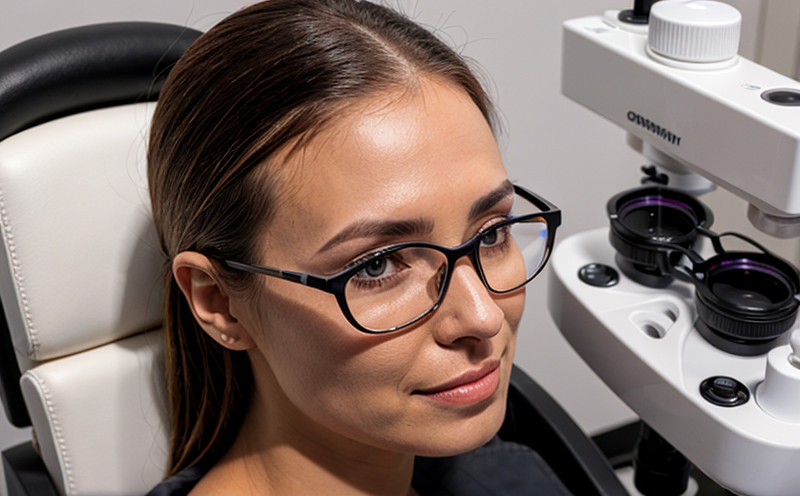EP Particulate Contamination Light Obscuration Testing
In the pharmaceutical sector, particulate contamination is a critical concern. Ensuring product purity and safety is paramount to maintaining trust with patients and regulatory compliance. The European Pharmacopoeia (EP) sets stringent standards for ensuring that all medicinal products are free from harmful contaminants. One of these standards is Light Obscuration Testing as outlined in EP Monograph 512, which aims to detect particulate matter through light obscuration.
This method involves the use of a laser beam that passes through a sample. As particles pass through this beam, they scatter or absorb some of the light, creating an observable signal. The intensity and duration of this signal indicate the size and quantity of particulates present in the sample. This technique is particularly useful for assessing products like ophthalmic solutions where even minimal contamination can have significant health implications.
The process begins with a thorough sample preparation to ensure that any existing particles are suspended or dissolved properly. The sample is then introduced into the light obscuration instrument, which measures the amount of light blocked by particulates as it travels through the beam. The equipment used for this test typically includes a laser source, a photodetector, and data acquisition software.
Accurate results are contingent upon precise calibration of instruments and adherence to standardized protocols. EP Monograph 512 specifies the conditions under which these tests must be conducted, including temperature control, humidity levels, and the dilution factor used for testing. These factors ensure consistency across different batches and manufacturing processes.
The test results are then analyzed to determine compliance with EP requirements. Any particulate matter exceeding allowable limits indicates a potential quality issue that needs addressing. This information is crucial not only for internal quality assurance but also for ensuring regulatory compliance, which can impact the approval process from health authorities like the European Medicines Agency (EMA).
In addition to its role in ensuring product purity, particulate contamination testing plays a vital part in maintaining patient safety and trust. By adhering to these stringent standards, pharmaceutical companies can minimize risks associated with particle-induced adverse reactions or efficacy issues.
Applied Standards
The European Pharmacopoeia (EP) is the primary regulatory document that governs this testing method. Specifically, EP Monograph 512 provides detailed guidance on how to perform light obscuration tests for detecting particulate contamination.
The United States Pharmacopeia (USP) and other international bodies like the World Health Organization (WHO) also provide relevant standards, although they may not be as specific as EP Monograph 512. These standards ensure consistency in testing protocols across different regions.
Compliance with these standards is essential for pharmaceutical companies aiming to meet regulatory requirements and maintain their reputation. Failure to adhere can result in product recalls, legal action, and reputational damage.
Competitive Advantage and Market Impact
Pharmaceutical companies that excel at particulate contamination testing gain a competitive edge by ensuring the highest quality standards. This can lead to increased market share as consumers trust brands that prioritize safety and efficacy.
In today’s highly regulated environment, meeting or exceeding EP standards is not just about compliance; it's also an investment in long-term success. Companies that demonstrate a commitment to such rigorous testing are more likely to attract investors and partners who value integrity and quality.
The ability to consistently produce high-quality products can open doors to new markets and partnerships, particularly with international health organizations and healthcare providers. Furthermore, companies that maintain stringent quality control measures may find themselves at the forefront of innovation, offering safer and more effective treatments.
Use Cases and Application Examples
Ophthalmic solutions are one area where particulate contamination testing is particularly critical. These products are often used directly on or near sensitive tissues like the eyes, making even small amounts of particulate matter potentially harmful.
During manufacturing processes, various stages can introduce particulates into ophthalmic solutions. For instance, during filling and stoppering operations, microscopic particles could be inadvertently introduced if proper precautions are not taken. Light obscuration testing helps identify these issues early in the production cycle, allowing for timely corrective actions.
Another application involves quality assurance checks before product release. By conducting regular light obscuration tests, manufacturers can ensure that each batch meets EP standards and is safe for use. This proactive approach not only enhances product safety but also reduces the risk of recalls or other disruptions to supply chains.
Pharmaceutical companies involved in clinical trials may also benefit from this testing method. Ensuring that trial samples meet strict particulate contamination limits can help maintain the integrity of research results and build confidence among stakeholders.





